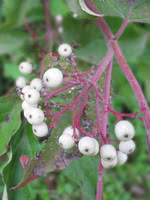Mon-Fri 9am - 5pm Mountain time
Gray Dogwood vs Grouseberry
Cornus racemosa
Vaccinium scoparium
CUSTOM GROW
CUSTOM GROW
Gray dogwood is a thicket-forming, deciduous shrub with greenish-white blossoms in open, terminal clusters. Young twigs are red and the fruit pedicels remain conspicuously red into late fall and early winter.
Fruit itself is a white, 1/4 in. drupe that usually does not remain on the shrub for long.
Great for naturalizing wild areas, this shrub attracts birds and other wildlife.
Grouseberry is a native, low-growing deciduous shrub known for its edible red berries. In early summer, it produces small, urn-shaped flowers ranging from white to pink that attract bees and other pollinators. The berries provide an important food source for many types of wildlife, including game birds such as grouse, which gives the plant its common name. People can also enjoy the berries fresh or in baked goods, though they can be difficult to harvest in large quantities.
Spreading by rhizomes, Grouseberry forms dense, broom-like mats that help stabilize soil and prevent erosion, while also providing cover for ground-nesting wildlife. It is commonly found beneath conifers in open forests, subalpine meadows, and occasionally on rocky slopes in mountainous regions. It is well-suited for naturalization, ecological restoration, and soil stabilization projects.

